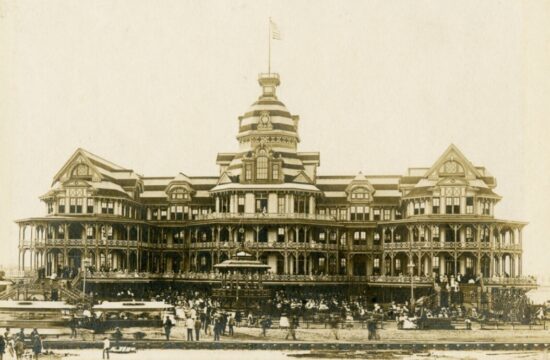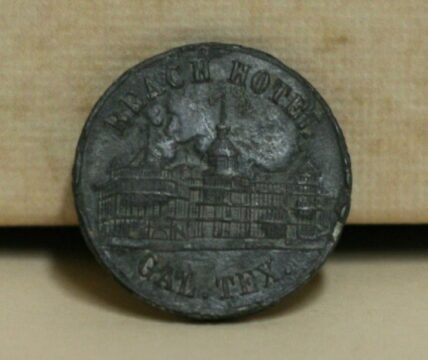
During the month of October, Rosenberg Library exhibited items related to the Beach Hotel, Galveston’s first oceanfront resort property. Opened in 1883, the impressive structure operated for just fifteen years before it burned to the ground in 1898.
In 1882, Galveston businessman William Henry Sinclair proposed the construction of a resort hotel along the Gulf of Mexico to attract more tourists to the island. Funded by investors in the Galveston City Railroad Company—of which Sinclair served as President—the Beach Hotel opened during the July 4 holiday in 1883 to much fanfare. Architect Nicholas J. Clayton designed the 4-story frame structure, which was built atop 300 cedar pilings anchored into the sand. The roof was painted in red and white stripes, and the building and trim were painted various shades of green.

Although the hotel remained a popular destination, financial difficulties led to its closing in 1895. The building had fallen into disrepair and was sold to Clarence Gueringer. Gueringer repainted the hotel’s exterior and completed renovated the interior in 1896. Despite these efforts, the hotel fell into bankruptcy the following year. After changing ownership once again, the hotel was forced to shut down its operations after city officials discovered that its cesspools were being emptied out directly into the Gulf of Mexico rather than being connected to the city’s sewer line.

A mysterious fire erupted at the hotel during the early morning hours of July 1898—just before it opened for the new summer season. Although local firefighters arrived on the scene quickly, strong winds prevented their containment of the blaze. Within a short time, the entire hotel had burned to the ground.
Ironically, had the hotel not burned in 1898, it would surely have been lost during the Great Storm of September 8, 1900. With the construction of the Seawall following that disaster, beachfront hotels are now offered significant protection from storm surges in the Gulf of Mexico.